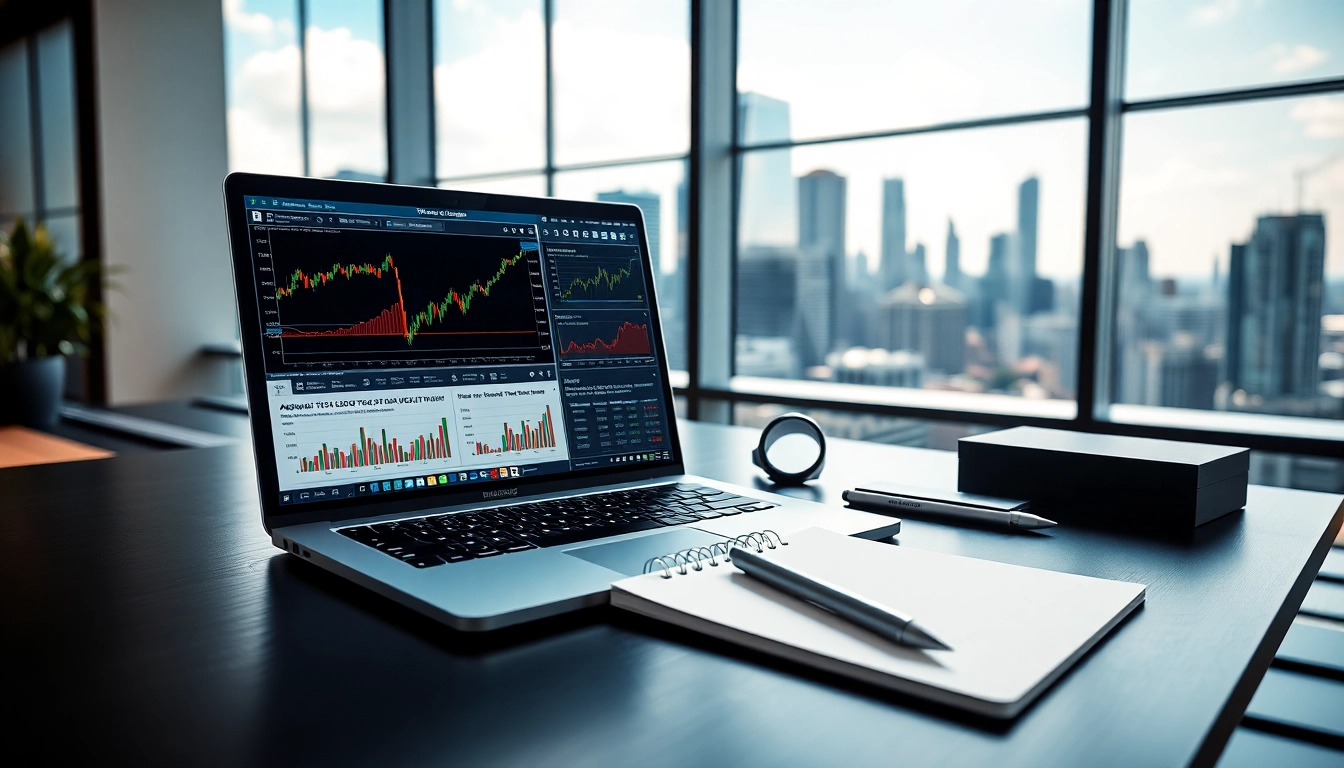Understanding AI Trading Fundamentals
What is AI Trading?
AI trading refers to the application of artificial intelligence algorithms and machine learning techniques to analyze financial markets and execute trades. It involves using complex quantitative models and vast amounts of data to identify trading opportunities, making trades at speeds and frequencies that are far beyond human capabilities. AI trading systems can adapt to market changes in real-time, continually learning from new data to improve their predictive accuracy. Traders who invest in ai trading can potentially enhance their trading strategies and performance.
Key Benefits of AI in Trading
AI trading offers numerous advantages over traditional trading methods. Here are some key benefits:
- Speed: AI trading systems can process vast amounts of information and execute trades in milliseconds, enabling traders to capitalize on fleeting market opportunities.
- Data Analysis: AI systems can analyze historical data and uncover patterns and correlations that human traders may overlook, resulting in more informed decisions.
- Emotionless Trading: AI trading eliminates the emotional aspect of trading, reducing the likelihood of rash decisions and behavioral biases influencing trading outcomes.
- Increased Efficiency: Automated trading through AI can lead to higher operational efficiency, as human resources can focus on strategy development and oversight rather than routine execution of trades.
- Risk Management: AI algorithms can assess risks in real-time and adapt their strategies accordingly, allowing for dynamic risk management.
Common Challenges Faced
Despite its many advantages, AI trading is not without its challenges. Some common obstacles include:
- Data Quality: The accuracy and reliability of AI trading depend heavily on the quality of data available. Poor data can lead to inaccurate predictions and ill-informed trading decisions.
- Overfitting: AI models can sometimes be too complex, resulting in overfitting where they perform exceedingly well on historical data but fail to generalize to new, unseen data.
- Market Volatility: Sudden market swings can significantly impact the performance of AI trading algorithms, which may not be designed to handle such unpredictability.
- High Competition: The proliferation of AI in trading has led to increased competition, with many firms leveraging similar technologies, making it harder to maintain a competitive edge.
- Regulatory Challenges: The use of AI in trading raises various regulatory concerns, and firms must navigate a complex landscape of compliance requirements.
Exploring AI Trading Algorithms
Types of Algorithms Used in AI Trading
AI trading utilizes a variety of algorithms to analyze market conditions and execute trades. Some of the most commonly employed algorithms include:
- Machine Learning Algorithms: These algorithms can learn from past trading data and improve their predictions over time. Examples include supervised learning (linear regression, decision trees) and unsupervised learning (clustering algorithms).
- Genetic Algorithms: Inspired by the process of natural selection, these algorithms evolve trading strategies over generations, optimizing for better performance based on historical data.
- Neural Networks: Mimicking the interconnected neurons in the human brain, neural networks can identify intricate patterns in data and adapt their strategies based on new information.
- Reinforcement Learning: This approach allows algorithms to learn by trial and error, optimizing their trading decisions based on the reward received from past trades.
- Sentiment Analysis Algorithms: These algorithms assess market sentiment through news articles, social media, and other sources, allowing traders to gauge the mood of investors and make informed decisions accordingly.
How to Choose the Right Algorithm
Selecting the most appropriate AI algorithm for trading requires careful consideration of several factors:
- Trading Objectives: Define your trading goals, including the desired balance of risk and return, and choose algorithms that align with these objectives.
- Data Availability: Consider the type and amount of historical data available, as different algorithms require varying levels of data to train effectively.
- Market Conditions: Reflect on the volatility and type of financial market (stocks, forex, cryptocurrencies) you are trading in, as some algorithms perform better under specific conditions.
- Technical Expertise: Assess your team’s technical skill set; some algorithms may require expertise in machine learning and programming to implement and maintain.
- Testing Capabilities: Ensure that the algorithm can be thoroughly backtested using historical data to gauge its potential performance before deploying it in live trading.
Algorithmic Trading vs. Traditional Trading
The differences between algorithmic trading and traditional trading are profound:
- Execution Speed: Algorithmic trading allows for near-instantaneous trade execution, whereas traditional trading typically involves delays, especially in manual processes.
- Volume of Trades: AI algorithms can execute thousands of trades simultaneously, while human traders operate at a vastly reduced scale.
- Data Utilization: Algorithmic trading can analyze and interpret vast datasets, whereas traditional trading often relies on smaller samples of data, risking incomplete insights.
- Decision-Making Process: AI trading employs data-driven and statistical models for decision-making, removing emotional influences, while traditional trading often incorporates psychological factors.
Best Practices for AI Trading Success
Risk Management in AI Trading
Effective risk management is paramount in AI trading. Best practices to consider include:
- Your Risk Tolerance: Define your acceptable level of risk before initiating algorithms, ensuring they align with your trading goals.
- Diversification: Implement strategies that diversify investments across multiple assets to reduce exposure to any single market adverse event.
- Stop-Loss Orders: Use stop-loss features in algorithms to automatically trigger selling at predetermined limits, minimizing potential losses.
- Regular Monitoring: Continuously monitor algorithm performance and adjust parameters as market conditions change to maintain effectiveness.
- Education and Training: Equip your trading team with the knowledge required to understand AI risk factors, advancements, and outcomes.
Analyzing Market Data Effectively
AI traders must focus on effectively analyzing market data to extract actionable insights. Key steps include:
- Data Preprocessing: Clean and preprocess datasets to ensure accuracy, removing outliers and errors before analysis.
- Feature Selection: Identify relevant features that contribute to predicting market movements, using techniques such as PCA (Principal Component Analysis).
- Real-Time Analysis: Employ real-time data feeds for the most current insights, enhancing the responsiveness of trading algorithms.
- Combining Data Sources: Leverage a mixture of structured (price data) and unstructured (news, social media, tweets) data for a holistic view of market conditions.
- Data Visualization: Utilize graphs and dashboards to visualize market trends and patterns, aiding in decision-making processes.
Backtesting Strategies for AI Algorithms
Backtesting is a crucial process for validating trading algorithms. Here’s how to effectively implement backtesting:
- Historical Data Selection: Choose high-quality historical data representative of varied market conditions for accurate backtesting.
- Backtesting Framework: Develop a rigorous framework using appropriate tools and software to simulate trading performance over the historical period.
- Performance Metrics: Use precise metrics such as Sharpe Ratio, maximum drawdown, and ROI to assess algorithm performance during the backtesting phase.
- Parameter Optimization: Fine-tune your algorithm parameters through systematic testing to find the most effective configuration.
- Out-of-Sample Testing: Separate data into training and testing sets to ensure that the backtested algorithm can generalize to new datasets.
Real-World AI Trading Applications
Case Studies of Successful AI Trading Firms
Several firms have successfully harnessed AI for trading. Notable examples include:
- Man AHL: This quantitative investment firm has leveraged machine learning techniques to enhance its predictive trading models and manage vast amounts of data.
- Two Sigma: Known for integrating AI into its systematic trading strategies, Two Sigma researches market behavior extensively to create effective trading algorithms.
- Renaissance Technologies: A pioneer in algorithmic trading, Renaissance employs complex models to predict price movements across various assets, yielding exceptional investment returns.
Identifying Trends Through AI Analysis
AI can effectively identify trends by analyzing historical patterns and shifting dynamics in market conditions. Techniques include:
- Time-Series Analysis: Employing statistical methods to classify historical price movements and anticipate future behavior, utilizing algorithms to find correlations and cycles.
- Sentiment Analysis: Gauging market sentiment through news and social media data to correlate public emotion with market actions.
- Technical Indicators: Implementing indicators like moving averages and Bollinger Bands to track and signal trends within trading strategies.
- Pattern Recognition: Leveraging AI’s ability to detect chart patterns and price formation for trend prediction.
Real-time Decision Making with AI
An essential advantage of AI in trading is real-time decision-making. This involves:
- Dynamic Adjustments: Algorithms adjusting trading decisions based on real-time data feeds and AI analysis of current market conditions.
- Event-Driven Trading: Algorithms set to trigger trades automatically based on specific news events or data releases, ensuring timely responses to market-moving information.
- Contextual Decision Checks: Utilizing AI to incorporate both underlying market conditions and potential impacts when deciding on trading strategies.
Measuring Performance in AI Trading
Key Metrics to Evaluate Trading Algorithms
Measuring the performance of AI trading algorithms involves analyzing several key metrics:
- Return on Investment (ROI): The return generated by an algorithm relative to its initial investment helps gauge profitability.
- Sharpe Ratio: This metric assesses risk-adjusted returns, enabling traders to evaluate performance relative to the level of risk taken.
- Maximum Drawdown: Understanding the most significant loss from a peak to a trough helps in assessing the risk associated with the trading strategy.
- Win Rate: The percentage of profitable trades compared to total trades provides valuable insight into an algorithm’s effectiveness.
- Alpha and Beta: These metrics measure the algorithm’s performance against a benchmark and its sensitivity to market movements, respectively.
Adjusting Strategies Based on Performance Data
To optimize trading strategies continually, adjustments based on performance data should be made, including:
- Regular Reviews: Conduct systematic assessments of algorithm performance against predetermined benchmarks to identify areas for improvement.
- Parameter Re-evaluation: Adjust parameters based on observed changes in market conditions, ensuring algorithms stay responsive to new data.
- Incorporating New Research: Update algorithms with the latest market research findings and innovations in AI technology to stay ahead of the competition.
- Iterative Testing: Continuously retest algorithms using recent historical data to manage any changes in market behavior effectively.
The Future of AI Trading: Trends and Predictions
The future of AI trading looks promising, shaped by evolving trends and advancements:
- Increased Accessibility: As AI tools become more accessible, individual traders will increasingly leverage AI for personal investments.
- Enhanced Predictive Capabilities: Ongoing improvements in machine learning will refine predictive algorithms, leading to better trading decisions under varied market conditions.
- Collaboration Between Humans and AI: More trading strategies will blend human intuition with AI capabilities, resulting in hybrid approaches to trading.
- Regulatory Developments: As AI’s role in trading expands, regulators will adapt to ensure fair market practices, impacting how AI trading systems operate.















Leave a Reply